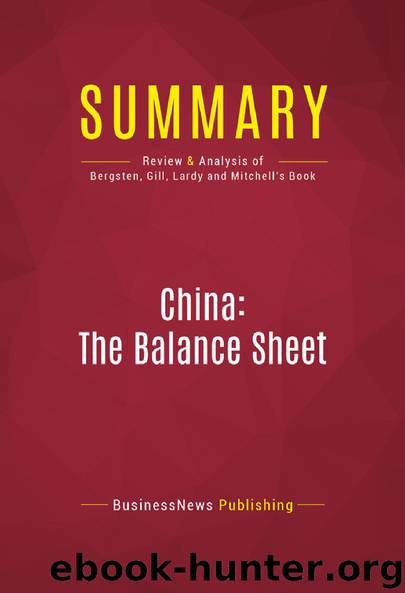Summary: China: The Balance Sheet by BusinessNews Publishing

Author:BusinessNews Publishing
Language: eng
Format: epub
Publisher: BusinessNews Publishing
Published: 2016-07-15T00:00:00+00:00
China in the World Economy: Opportunity or Threat?
In 2004, China became the world’s third larges t trading economy. Its economic rise has several implications for the global economy. China has become a major engine of economic growth; from 2000-2005, its imports have tripled from $225 billion to $660 billion, and it has accounted for about 12 percent of global trade growth. Its burgeoning import demand is raising the relative wages of skilled labor, the profit share of output, and commodity prices.
In theory, the United States should find it easier than low-income countries to adjust to China’s global economic rise. In practice, however, trade disputes are inherent and inevitable, and China’s $202 billion trade surplus with the United States only exacerbates frictions. Additional factors unique to the U.S.-China relationship risk escalating frictions into more serious political problems.
First, China is a transition economy that combines a mix of expanding market forces with a receding, but still powerful, government hand; disputes can be difficult to resolve when one party sees outcomes as generated by market forces and the other party sees them as policy choices dictated by a state-led growth model. Second, China remains an authoritarian, communist state, such that no one can say with certainty that China’s economic rise will not ultimately pose a security threat to the U.S. and its allies. Third, narrow trade disputes could escalate to become a broader “China problem” because most Americans find China’s limitations of human rights and freedoms so repugnant.
It is important to bear in mind that U.S.-China economic relations are determined in large part by the United States. Fortunately, the United States has regained much of its economic self-confidence, although its economy is far from invulnerable. After the sizable surplus achieved during Clinton’s administration, large budget deficits have reappeared. A second major problem is that income distribution has worsened steadily, with the real wages of hourly American workers being lower today than in 1973. Thus, there’s been a significant U.S. backlash against globalization, since significant adjustment costs, notably job losses and lower wages totaling about $50 billion per year, are involved in trade liberalization.
At or near the top of any issue list is the ever-growing deficit that the United States has in its bilateral trade with China. In 2005, China’s global trade surplus soared to more than $100 billion. United States exports to China would need to grow almost six times more rapidly than U.S. imports from China just to keep the trade imbalance from increasing further.
The U.S. bilateral trade deficit with China is a complex and multifaceted challenge. Chinese officials frequently claim that the trade imbalance would be less if the U.S. would approve more high technology exports to China. However, if in 2005, the Department of Commerce had approved all the rejected licenses, the trade deficit would have been smaller by only 0.006 percent. The most common reason given by China’s critics for the growing imbalance is that China is pursuing a mercantilist trade strategy, restricting access to its market while aggressively supporting exports.
Download
This site does not store any files on its server. We only index and link to content provided by other sites. Please contact the content providers to delete copyright contents if any and email us, we'll remove relevant links or contents immediately.
| Anthropology | Archaeology |
| Philosophy | Politics & Government |
| Social Sciences | Sociology |
| Women's Studies |
The Secret History by Donna Tartt(18802)
The Social Justice Warrior Handbook by Lisa De Pasquale(12121)
Thirteen Reasons Why by Jay Asher(8762)
This Is How You Lose Her by Junot Diaz(6749)
Weapons of Math Destruction by Cathy O'Neil(6115)
Zero to One by Peter Thiel(5657)
Beartown by Fredrik Backman(5574)
The Myth of the Strong Leader by Archie Brown(5400)
The Fire Next Time by James Baldwin(5220)
How Democracies Die by Steven Levitsky & Daniel Ziblatt(5107)
Promise Me, Dad by Joe Biden(5069)
Stone's Rules by Roger Stone(5010)
100 Deadly Skills by Clint Emerson(4820)
A Higher Loyalty: Truth, Lies, and Leadership by James Comey(4820)
Rise and Kill First by Ronen Bergman(4678)
Secrecy World by Jake Bernstein(4615)
The David Icke Guide to the Global Conspiracy (and how to end it) by David Icke(4598)
The Farm by Tom Rob Smith(4419)
The Doomsday Machine by Daniel Ellsberg(4395)
